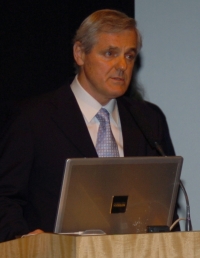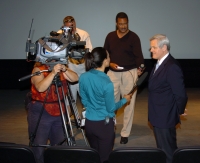True Revelations: A Da Vinci Detective Speaks at Calit2
By Maureen C. Curran
San Diego, CA, May 22, 2006 -- On the eve of the international opening of the movie "The Da Vinci Code," based on Dan Brown's best-selling work of fiction, Calit2 presented the real thing. On May 17, the UCSD division hosted a seminar and press conference in Atkinson Hall by UCSD alum Maurizio Seracini, one of the book’s only living nonfictional characters.
|
Over the last 30 years, Seracini's work has created a new discipline, where art and architecture intersect with science and engineering. The ultimate goal is nothing less than the conservation of cultural heritage worldwide. Calit2 UCSD director Ramesh Rao was delighted to introduce Seracini to the more than 200 attendees: "When we learned of Maurizio's work, many of us began to sense that he and Calit2 were made for each other. His techniques make him look like an engineer and a data analyst to many, but the object of his inquiry is art and architecture, an unusual combination."
|
"'The Da Vinci Code' is a work of fiction," Seracini told the audience. "By contrast, I am interested in facts -- using scientific techniques to discover objective knowledge about a work of art and, in the process, uncovering a hidden treasure beyond imagination."
Using noninvasive, nondestructive techniques and technologies, including a wide variety of infrared, ultra-violet, and other imaging technologies, Seracini examines art, architecture and other cultural artifacts. The goal of his scientific analysis is to determine the techniques, materials, state of conservation and history of an artwork.
"His work is potentially disruptive to prevailing beliefs, and this too fits with what we set out to accomplish at Calit2," said Calit2's Rao. Art historians and much of Italy were unhappy to learn in 2002 that the "Adoration of the Magi," considered the most valuable da Vinci masterpiece still in Italy, was not "painted" (meaning colored) by da Vinci. It took about four years to gain acceptance for this finding from the art history world. However, the loss in iconography was greatly surpassed by the results of further examination of the painting using multispectral diagnostic imaging, followed by analytical diagnostics.
|
One of the most spectacular scenes is a masterpiece set of figures, a layout of faces, each portrait a work of art on its own. This image was presented for the first time anywhere to a packed house last February in the Calit2 Auditorium. The rapt audience burst into applause when it was unveiled.
The resulting work from this investigation is part of a major new exhibition at the Uffizi Gallery in Florence, “The Mind of Leonardo Da Vinci,’ which opened on March 28 to critical acclaim. "We do justice to Leonardo; we are using technology to understand his masterpieces. I think he would have been happy about that," said Seracini.
For the seminar, Seracini worked with Calit2 researchers to create an interactive "fly into the painting" rendering where the visible light version, as it hangs in the Uffizi, can be faded in and out with the infrared image which reveals the underdrawing. Seracini pointed out that "this is probably the only place in the world where you can see this with such quality."
"The technique that we used this time loses no resolution," explained Calit2 collaborator John Graham, chief scientist for the San Diego State University's Visualization Center. Graham is also developing a version of the Adoration fly-through to show on the 4K digital cinema projection system in Calit2's auditorium. "I can bring up the dataset now in 4K, but I cannot yet fade them. Soon I will be able to," promised Graham.
The Florence-based Seracini enjoyed spending the week at Calit2, thanks to "the enormous technological potential that I found here," he said. Seracini is discussing potential long-term collaborative projects with Calit2 researchers from UCSD and SDSU on the development of new scanning technologies to analyze art, architecture and artifacts. He graduated from UCSD (class of '73) with a degree in mathematics and bioengineering (formerly known as "AMES").
In its first three days "The Da Vinci Code" film took in more than $224 million at the international box office, the second-highest opening gross in movie history. One day after the movie came out, Britain's Channel 4 premiered "The Da Vinci Detective," a two-hour documentary about Seracini shot in part at Calit2. The program calls him "a 21st century Renaissance man" who has "made his name by ingeniously adapting the latest medical and military technology to reveal the secrets of great artistic masterpieces." For the documentary, a camera crew trailed the UCSD alum around the world for 18 months for what the TV network calls "the real Leonardo thriller."
Related Links
The Mind of Leonardo: Scientific Analysis of the Adoration of the Magi
The Da Vinci Detective, Channel 4 (UK)
Related Articles
Decoding Da Vinci: At Calit2, UCSD Alumnus Shows Stunning Discoveries





